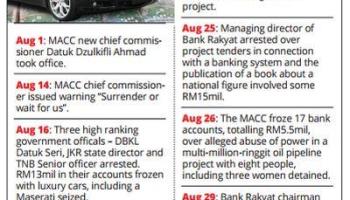 Success story: The Pinnacle@Duxton, a HDB public housing estate, in the Tanjong Pagar district of Singapore. The HDB programme provides the government with an effective means to ensure targeted housing supply meant for community dwelling. – Bloomberg
Success story: The Pinnacle@Duxton, a HDB public housing estate, in the Tanjong Pagar district of Singapore. The HDB programme provides the government with an effective means to ensure targeted housing supply meant for community dwelling. – BloombergBest practices from from HDB should be carefully studied
IT is increasingly a cause for concern to see the rising cost of living leading to a significant erosion of income. This results in more youths and job entrants unable to afford decent dwelling, be it in urban or sub-urban areas.
Therefore, it has become a pressing policy matter to find an effective solution to keep real estate prices in check. Many governmental agencies have been set up, but affordability remains a problem.
> Current state of health
From property developers to banks offering mortgages, the real estate sector supply chain has a high correlation with domestic economic performance.
According to the National Property Information Centre (NAPIC), the Malaysian House Price Index growth has been moderating since 2014.
The index had eased to 7.2% in the fourth quarter last year, down from a 7.4% expansion in the previous quarter. It is the fifth consecutive quarter of slower pace of growth.
Similarly, Malaysia’s gross domestic product (GDP) growth had tapered to 4.0% in the second quarter this year, down from 4.2% in the previous quarter.
Notwithstanding the current sluggish economic conditions, the pertinent issue surrounding the real estate segment is affordable housing.
>Severely unaffordable
Even though broad property prices growth have plateaued, the high absolute price to own a house continues to be out of reach for the common Malaysian.
According to the report “Making Housing Affordable” by Khazanah Research Institute, the overall Malaysian housing market is ‘seriously unaffordable’.
Using the “median-multiple ratio” standard by the United Nations Centre for Human Settlement at the World Bank, a housing market is considered “affordable” if the house price to household income ratio is below 3.0 times.
The study conducted by Khazanah Research Institute, following the latest available data by the Department of Statistics, indicated that the overall Malaysian median-multiple in 2014 was 4.4 times.
More worryingly, the median multiple ratio for Kuala Lumpur (5.4 times), Penang (5.2 times), Terengganu (5.5 times) and Sabah (5.1 times) are considered to be ‘severely unaffordable’.
According to NAPIC data in the first quarter of the year, the median residential property sale transaction price in Kuala Lumpur was within the range of RM400,000 to RM500,000.
Assuming that the property price is RM450,000, after paying the 10% down payment deposit and taking a 35- year tenure housing loan at 4.5% interest per annum, the monthly mortgage repayment comes up to slightly over RM1,900.
Meanwhile, the surveyed salary of a four-to-five-year experienced sales manager with a university degree was reportedly at between RM5,000 and RM8,000 per month, according to a local recruitment specialist report.
Effectively, this means that the manager is looking at a house-to-individual income ratio of 4.7 to 7.5 times if he or she were to purchase the Kuala Lumpur property on his or her own capacity.
Moreover, given Department of Statistics’ expectation of 1.2% annual population growth rate between 2016 and 2020, Malaysia’s demography will have to accommodate a projected 1.6 million more people by the end of the decade.
Housing is a pressing socioeconomic issue for the long term not only in Malaysia but also worldwide. It has to be sustainable and affordable.
>Focus on sustainable supply side dynamics
Fundamentally, housing affordability is an income issue.
Given the high absolute value of real estates, household income – at a much lower base – would have to multiply much higher to catch up to the affordability threshold.
To extrapolate it further, even with higher income growth, would real estate ever be considered ‘affordable’?
A conventional profit maximisation motive could mean that property developers would eventually price their units in tandem with income growth rates, therefore creating the ever elusive ‘affordability’.
Keep in mind that there is no lack of demand for housing in Malaysia in light of the relatively young demographic.
In 2016, the estimated age group younger than 24 years old of around 13.4 million people makes up 43% of total population.
Besides, the average household size is expected to shrink from 4.6 people in 2000 to an estimated 4.0 people by the end of the decade, according to Khazanah Research Institute.
>More residential units would be required for dwelling.
Essentially, policy makers should focus more on the supply side dynamics to tackle the issue of home ownership and also on sustainable policies to ease the cost of ownership – especially for first- time home buyers.
Under the 11th Malaysia Plan, the government has already outlined the need for affordable housing – especially for the bottom 40% of households – to alleviate the increasing cost of living.
The government targets to provide 606,000 new affordable houses during course of the 11th Malaysia Plan spanning from 2016 to 2020, introduce an integrated database to match supply and demand dynamics and also establish a land bank for future affordable housing projects.
This would be a continuation of the Program Perumahan Rakyat 1Malaysia (PR1MA), Ruman Idaman Rakyat and Rumah Mesra Rakyat initiatives.
The government looks set to establish a land bank for houses and an integrated database for all relevant stakeholders to match demand and supply dynamics.
Across the straits, the Singapore Housing and Development Board (HDB) is often cited as a success story in providing affordable and quality homes.
The HDB programme is a comprehensive nationwide strategy that aligns the government’s legal powers to acquire land for public housing purposes, act as a central authority on township development, while leveraging on the Central Provident Fund as a financing means to ensure affordability.
Moreover, there is a holistic township planning whereby the development of physical HDB flat infrastructure is complemented by socioeconomic integration that promotes a cohesive society.
No doubt there are studies that indicate Singapore’s median multiple ratio is around 5.0 times in 2015, thereby classified as ‘severely unaffordable’.
The scarcity of land in the island state limits the potential for competitive supply of land.
Nevertheless, the comprehensive central planning that the Singapore government employs allows it to have a firm grip on keeping property prices in check.
In short, the HDB programme provides the government with an effective means to ensure targeted housing supply meant for community dwelling.
Given that Singapore’s home ownership rate has increased from 29% in the 1970s to close to 90% in 1990 and a vibrant resale market for the private sector, it is a considerable success story for providing quality living standards for the nation.
While it would likely be a gigantic task for other countries to emulate Singapore’s public housing policy from scratch in light of the legal matters of land and elements of socioeconomic welfare distribution, the best practices from HDB should be carefully studied.
>Housing matter should be top on policy priority
In Malaysia, land matter is a state matter. For a comprehensive public housing plan to take off, the government would have to put up an economically viable proposal to develop new townships across the nation with a cost effective structure.
The Urban Wellbeing, Housing and Local Government Ministry is mulling over the idea of developing a ‘Youth City’ township to cater to the young population.
Perhaps that could be a platform for the government to walk the talk and deliver value-added townships for affordable housing.
On the other end of the equation, besides providing dwelling space, real estate is also an asset class that yields cash flow from rental and also capital appreciation through time.
Therefore, it is imperative that the housing market price should never be trapped in an asset class bubble.
The 2008 United States’ sub-prime mortgage crisis serves as a grave reminder of the dire consequences and the impact on the real economy.
Fortunately, Bank Negara has already in place various macro-prudential policies since 2010 such as limiting loan-to-value ratio to 70% for home financing, and increase in real property gain tax to 10% for sales of real estate within two years to stem real estate market speculation activities.
In light of these, the recent consideration to allow property developers to offer home buyers financing at a much steeper financing cost of 12% interest rate per annum should be deliberated properly.
It is one matter to provide easier credit facility to own a property but it is an entirely different matter to compromise on the people’s capabilities to service the loan in the longer run and the spillover impact on real estate prices.
In short, housing is a necessity and it is imperative for authorities to have a policy interest in the issue.
The policy challenges going forward would only be more challenging as demand for housing continues to surge. It would be interesting to take stock of the plan that government has in mind come Budget 2017 on 21 October.
By Manokaran Mottain
Manokaran Mottain is the Chief Economist at Alliance Bank Malaysia Bhd
Related Stories:
Related posts:
Malaysian income: bread and butter, affordability of owing a house
Malaysian homes more unaffordable than Singapore, Japan and the US; Budget 2015 brings little joy
Young adults in developed countries rent, we buy houses for good
Cars are more expensive than houses? A house can buy how many cars?
How to allocate your money wisely: lessons from my father
When will the property market pick up?
Unemployment in Malaysia is rising, the latest data released by the
Statistics Department show. The obvious correlation to the rise i...

















